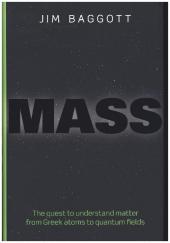 Neuerscheinungen 2017Stand: 2020-02-01 |
Schnellsuche
ISBN/Stichwort/Autor
|
Herderstraße 10
10625 Berlin
Tel.: 030 315 714 16
Fax 030 315 714 14
info@buchspektrum.de |

Jim Baggott
Mass
The quest to understand matter from Greek atoms to quantum fields
2017. 368 p. 241 mm
Verlag/Jahr: OXFORD UNIVERSITY PRESS; OUP OXFORD 2017
ISBN: 0-19-875971-1 (0198759711)
Neue ISBN: 978-0-19-875971-3 (9780198759713)
Preis und Lieferzeit: Bitte klicken
Jim Baggott explores how our understanding of the nature of matter, and its fundamental property of mass, has developed, from the ancient Greek view of indivisible atoms to quantum mechanics, dark matter, the Higgs field, and beyond. He shows how the stuff of the universe is proving more elusive and uncertain than we ever imagined.
Everything around us is made of ´stuff´, from planets, to books, to our own bodies. Whatever it is, we call it matter or material substance. It is solid; it has mass. But what is matter, exactly? We are taught in school that matter is not continuous, but discrete. As a few of the philosophers of ancient Greece once speculated, nearly two and a half thousand years ago, matter comes in ´lumps´, and science has relentlessly peeled away successive layers of matter to
reveal its ultimate constituents.
Surely, we can´t keep doing this indefinitely. We imagine that we should eventually run up against some kind of ultimately fundamental, indivisible type of stuff, the building blocks from which everything in the Universe is made. The English physicist Paul Dirac called this ´the dream of philosophers´. But science has discovered that the foundations of our Universe are not as solid or as certain and dependable as we might have once imagined. They are instead built from ghosts and phantoms, of a
peculiar quantum kind. And, at some point on this exciting journey of scientific discovery, we lost our grip on the reassuringly familiar concept of mass.
How did this happen? How did the answers to our questions become so complicated and so difficult to comprehend? In Mass Jim Baggott explains how we come to find ourselves here, confronted by a very different understanding of the nature of matter, the origin of mass, and its implications for our understanding of the material world. Ranging from the Greek philosophers Leucippus and Democritus, and their theories of atoms and void, to the development of quantum field theory and the
discovery of a Higgs boson-like particle, he explores our changing understanding of the nature of matter, and the fundamental related concept of mass.
The book is very clearly structured and has a glossary, so ´dipping´ is facilitated. The author condenses and combines sources as listed in his bibliography. Michael Jewess, Royal Society of Chemistry Historical Group newsletter
Jim Baggott is a freelance science writer. He was a lecturer in chemistry at the University of Reading but left to work with Shell International Petroleum Company and then as an independent business consultant and trainer. His many books include Origins: The Scientific Story of Creation (OUP, 2015), Higgs: The Invention and Discovery of the ´God Particle´ (OUP, 2012), A Quantum Story: A History in 40 Moments (OUP, 2011) and A Beginner´s
Guide to Reality (Penguin, 2005).


